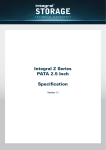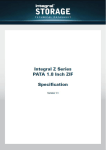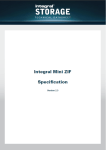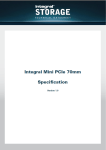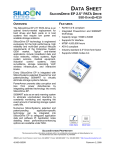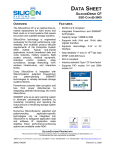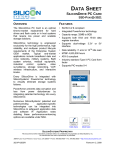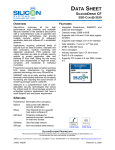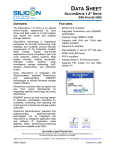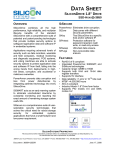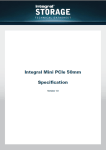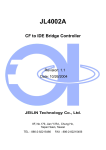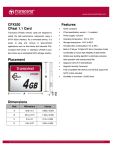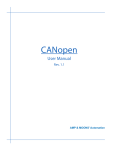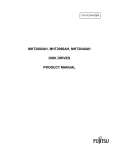Download Integral INAFM8G44VMXB flash memory
Transcript
Features: Standard ATA/IDE Bus Interface - 512 Bytes / Sector ATA command set compatible Selectable Master/Slave Setting Capacities - 8GB up to 64GB (SLC or MLC) Data Transfer mode - Support Data Transfer up to PIO mode 6 Support Data Transfer up to Multiword DMA mode 2 Support Data Transfer up to Ultra DMA mode 5 Performance - - Integral Z Series (MLC) Sustain Read Speed up to 43MB/s Sustain Write Speed up to 36MB/s Integral E Series (SLC) (Pls call for availability) Sustain Read Speed up to 45MB/s Sustain Write Speed up to 44MB/s Temperature Ranges 00C to 700C for operating environment - 250C to 850C for storage environment Industrial grade (Pls call for availability) -400C to 850C for operating environment -400C to 850C for storage environment Operating Voltage - 3.3V 5.0V Standard Female IDE Connector - 44-pin Vertical / Horizontal 40-pin Vertical / Horizontal (with Power adapter, 4 pin LP4 power connector) Intelligent ATA/IDE Module Commercial grade Built-in Embedded Flash File System Implements dynamic wear-leveling algorithms and static wear-leveling algorithms to increase endurance of flash media Built-in ECC corrects up to 12 random bits error per 512 bytes RoHS Compliance 2 TABLE OF CONTENTS 1.0 BLOCK DIAGRAM ..................................................................................................................... 4 2.0 SPECIFICATION ........................................................................................................................ 4 2.1 PIN ASSIGNMENTS ................................................................................................................ 4 2.2 PIN DESCRIPTION................................................................................................................. 5 2.3 JUMPER SETTING .................................................................................................................. 7 2.3.1 44pin (H/V) Jumper Settings ................................................................................. 7 2.3.2 40pin V Jumper Settings ......................................................................................... 7 2.3.3 40pin H Jumper Settings ........................................................................................ 8 3.0 ELECTRICAL CHARACTERISTICS ....................................................................................... 9 3.1 ABSOLUTE MAXIMUM RATING ............................................................................................. 9 3.2 DC CHARACTERISTICS OF 5.0V I/O CELLS(HOST INTERFACE) ......................................... 9 3.3 AC CHARACTERISTICS ........................................................................................................ 10 3.3.1 PIO Data Transfer ................................................................................................ 10 3.3.2 Multiword DMA Data Transfer ............................................................................ 12 3.3.3 Ultra DMA Data Transfer ..................................................................................... 15 3.4 POWER MANAGEMENT ....................................................................................................... 21 4.0 SOFTWARE INTERFACE ....................................................................................................... 21 4.1 ATA TASK FILE REGISTERS ................................................................................................ 21 4.2 COMMAND SETS .................................................................................................................. 21 4.3 IDENTIFY DRIVE INFORMATION ....................................................................................... 22 5.0 PHYSICAL DIMENSION ........................................................................................................ 25 5.1 44PIN HORIZONTAL ............................................................................................................ 25 5.2 44PIN VERTICAL .................................................................................................................. 26 5.3 40PIN VERTICAL .................................................................................................................. 27 5.4 40PIN HORIZONTAL (CONNECTOR AT TOP) ..................................................................... 28 5.5 40PIN HORIZONTAL (CONNECTOR AT BOTTOM) .............................................................. 29 3 1.0 Block Diagram 2.0 Specification 2.1 Pin Assignments Pin Pin Name Pin Pin Name 01 -RESET 02 GND 03 DD7 04 DD8 05 DD6 06 DD9 07 DD5 08 DD10 09 DD4 10 DD11 11 DD3 12 DD12 13 DD2 14 DD13 15 DD1 16 DD14 17 DD0 18 DD15 19 GND 20 KEY_PIN(OPEN) 21 DMARQ 22 GND 23 -DIOW:STOP 24 GND 25 -DIOR:-HDMARDY:HSTOBE 26 GND 27 IORDY:DDMARDY:DSTROBE 28 CSEL 29 -DMACK 30 GND 31 INTRQ 32 IOIS16 33 DA1 34 -PDIAG:-CBLID 35 DA0 36 DA2 37 -CS0 38 -CS1 39 -DASP 40 GND 41* VCC 42* VCC 4 43* GND 44* NC * Note: Pin 41~44 only for 44pin AFM 2.2 Pin Description Pin No. Signal I/O* Description 01 -RESET I Hardware reset signal from the host 17,15,13,11,09,07, DD0~DD15(Device Data) I/O 16-bit bi-direction Data Bus. DD(7:0) are 05,03,04,06,08,10, used for 8-bit register transfers. 12,14,16,18 21 DMARQ(DMA Request) O For DMA data transfers. Device will assert DMARQ when the device is ready to transfer data to or from the host. 23 -DIOW(I/O Write) I This is the strobe signal used by the host to write to the device register or Data port STOP(Stop UDMA Burst) The host assert this signal during an UDMA burst to stop the DMA burst 25 IORDY(I/O channel ready) O This signal is used to temporarily stop the host register access (read or write) when the device is not ready to respond to a data transfer request. DDMARDY(UDMA ready) The device will assert this signal to indicate that the device is ready to receive UDMA data-out burst. DSTROBE(UDMA data When UDMA mode DMA Read is active, strobe) this signal is the data-in strobe generated by the device. 28 CSEL(Cable select) I This pin is used to configure this device as Device 0 or Device 1. 29 -DMACK(DMA I This signal is used by the host in respond 5 acknowledge) 31 INTRQ(Interrupt) to DMARQ to initiate DMA transfer. O When this device is selected, this signal is the active high Interrupt Request to the host Pin No. Signal I/O Description 32 IOIS16 O During PIO transfer mode0,1or 2, this pin indicates to the host the 16-bit data port has been addressed and the device is prepared to send or receive a 16-bit data word. When transferring in DMA mode, the host must use a 16-bit DMA channel and this signal will not be asserted. 35, 33, 36 DA0~DA2(Device Address) I This is 3-bit binary coded Address Bus. 34 -PDIAG(Passed diagnostics) I/O This signal will be asserted by Device 1 to indicate to Device 0 that Device 1 has completed diagnostics, -CBLID(Cable assembly type identify) 37, 38 -CS0, -CS1(Chip select) I These signals are used to select the Command Block and Control Block registers. When –DMACK is asserted, -Cs0 and –Cs1 shall be negated and transfers shall be 16-bit wide. 39 -DASP(Device active, Device I/O 1 present) During the reset protocol, -DASP shall be asserted by Device 1 to indicate that the device is present. 41*, 42* VCC P Power supply 02, 19, 22, 24, 26, 30, GND -- Ground. 40, 43* *Note: “I” An input from the host system to the device. “O” An output from the device to the host system. “I/O” An input/output(bi-direction) common. “P” Power supply. 6 “Pin41~44” Only for 44pin AFM 2.3 Jumper Setting Follow diagram define AFM Master/Slave Jumper (J2) settings 2.3.1 44pin (H/V) Jumper Settings Master Slave Cable Select 44pin Horizontal 44pin Vertical 2.3.2 40pin V Jumper Settings Master Slave 40pin Vertical 7 Cable Select 2.3.3 40pin H Jumper Settings Master Slave 40pin Horizontal 8 Cable Select 3.0 Electrical Characteristics 3.1 Absolute Maximum Rating Item Symbol Parameter MIN MAX Unit 1 VDD-VSS DC Power Supply -0.3 +5.5 V 2 VIN Input Voltage Vss-0.3 VDD+0.3 V 3 Ta Operating Temperature 0 +70 0C 4 Tst Storage Temperature -25 +85 0C Parameter Symbol MIN TYP MAX Unit VDD Voltage VDD 3.0 3.3 3.6 V 4.5 5.0 5.5 V 3.2 DC Characteristics of 5.0V I/O Cells(Host Interface) Symbol Parameter Conditions Vil Input Low Voltage TTL(5V) Vih Input High Voltage Vil Input Low Voltage Vih Input High Voltage Vol Output Low Voltage Voh Iin MIN TYP MAX Unit -- -- 0.85 V 1.25 -- -- V -- -- 1.05 V 1.75 -- -- V |Iol| = 4~32 mA -- -- 0.4 V Output High Voltage |Ioh|= 4~32 mA 2.4 -- -- V Input Leakage Current No pull-up or pull -10 ±1 10 μA -10 ±1 10 μA TTL(3.3V) down Ioz Tri-state Output Leakage Current 9 3.3 AC Characteristics 3.3.1 PIO Data Transfer 10 PIO timing parameters t0 Cycle time t1 Address valid to (min) DIOR-/DIOW- setup (min) t2 DIOR-/DIOW- (min) t2i DIOR-/DIOW- recovery time Mode 0 Mode 1 Mode2 Mode 3 Mode 4 Note ns ns ns ns ns 600 383 240 180 120 70 50 30 30 25 165 125 100 80 70 1 -- -- -- 70 25 1 1,4 (min) t3 DIOW- data setup (min) 60 45 30 30 20 t4 DIOW- data hold (min) 30 20 15 10 10 t5 DIOR- data setup (min) 50 35 20 20 20 t6 DIOR- data hold (min) 5 5 5 5 5 t6z DIOR- data tristate (max) 30 30 30 30 30 2 t9 DIOR-/DIOW- to address 20 15 10 10 10 10 0 0 0 0 0 35 35 35 35 35 1250 1250 1250 1250 1250 5 5 5 5 5 valid hold tRD (min) Read Data Valid to IORDY active (if IORDY initially low after tA) (min) tA IORDY Setup time tB IORDY Pulse Width tC IORDY assertion to release (max) 3 (max) Notes1. t0 is minimum total cycle, t2 is minimum DIOR-/DIOW- assertion time, and t2i is the minimum DIOR-/DIOW- negation time. A host implementation shall lengthen t2i to ensure that t0 is equal to or greater than the value reported in the devices IDENTIFY DEVICE data. A device implementation shall support any length host implementation. 2. This parameter specifies the time from the negation edge of DIOR- to the time that the data is released by the device. 3. The delay from the activation of FIOR- or DIOW- until the state of IORDY is first sampled. If IORDY is inactive then the host shall wait until IORDY is active before the PIO cycle is complete. If the device is not driving IORDY negated at the tA after the activation of DIOR- or DIOW-, that t5 shall be met and tRD is not applicable. If the device is driving IORDY 11 negated at the time tA after the activation of DIOR- or DIOW-, then tRD shall be met and t5 is not applicable. 4. Mode may be selected at the highest mode for the device if CS(1:0) and DA(2:0) do not change between read or write cycle or selects at the highest mode supported by the slowest device if CS(1:0) and DA(2:0) do change between read or write cycles. 3.3.2 Multiword DMA Data Transfer (Initialing a Multiword DMA data burst) 12 (Sustaining a Multiword DMA data burst) (Device terminating a Multiword DMA data burst) 13 (Host terminating a Multiword DMA data burst) Multiword DMA timing parameters Mode 0 Mode 1 Mode2 ns ns ns Note t0 Cycle time (min) 480 150 120 See note tD DIOR-/DIOW- asserted pulse width (min) 215 80 70 See note tE DIOR- data access (max) 150 60 50 tF DIOR- data hold 5 5 5 tG DIOR-/DIOW- data setup 100 30 20 tH DIOW- data hold (min) 20 15 10 tI DMACK to DIOR-/DIOW- setup (min) 0 0 0 tJ DIOR-/DIOW- to DMACK hold (min) 20 5 5 tKR DIOR- negated pulse width (min) 50 50 25 See note tKW DIOW- negated pulse width (min) 215 50 25 See note tLR DIOR- to DMACK delay (max) 120 40 35 tLW DIOW- to DMACK delay (max) 40 40 35 tM CS(1:0) valid to DIOR-/DIOW- (min) 50 30 25 tN CS(1:0) hold (min) 15 10 10 tZ DMACK- to read data released (max) 20 25 25 (min) (min) Notes- t0 is the minimum total cycle. tD is the minimum DIOR-/DIOW- assertion time, and tK(tKR or tKW, 14 as appropriate) is the minimum DIOR-/DIOW- negation time. A host shall lengthen tD and/or tK to ensure that t0 is equal to the value reported in the devices IDENTIFY DEVICE data. 3.3.3 Ultra DMA Data Transfer Ultra DMA data burst timing requirements 15 Ultra DMA data burst timing descriptions 16 (Initialing an Ultra DMA data-in burst) (Sustained Ultra DMA data-in burst) 17 (Device terminating an Ultra DMA data-in burst) (Host terminating an Ultra DMA data-in burst) 18 (Initialing an Ultra DMA data-out data burst) (Sustained Ultra DMA data-out burst) 19 (Host terminating an Ultra DMA data-out burst) (Device terminating an Ultra DMA data-out burst) 20 3.4 Power Management System Power Consumption: (Ta = 0 to 700C) Symbol Parameter Conditions MIN TYP MAX Unit Iccr Read current 5V - 100 - mA Iccw Write current 5V - 105 - mA Ipd Power down current 5V - 0.2 0.4 mA Iccr Read current 3.3V - 150 - mA Iccw Write current 3.3V - 160 - mA Ipd Power down current 3.3V - 0.3 - mA 4.0 Software Interface 4.1 ATA Task File Registers The I/O decoding of each register is as follows -CS1 -CS0 A2 A1 A0 -DIOR=0(-DIOW=1) -DIOW=0(-DIOR=1) 1 0 0 0 0 Data(Read) Data(Write) 1 0 0 0 1 Error Feature 1 0 0 1 0 Sector Count Sector Count 1 0 0 1 1 Sector Number (LBA7-0) Sector Number (LBA7-0) 1 0 1 0 0 Cylinder Low (LBA 15-8) Cylinder Low (LBA 15-8) 1 0 1 0 1 Cylinder High (LBA 23-16) Cylinder High(LBA 23-16) 1 0 1 1 0 Drive/Head (LBA 27-24) Drive/Head (LBA 27-24) 1 0 1 1 1 Status Command 0 1 1 1 0 Alternate Status Device Control 0 1 1 1 1 Drive Address Reserved 4.2 Command Sets Below table summarizes the AFM (PATA DOM) command set with the paragraphs that follow describing the individual commands and task file for each command. No. Command Set Code FR SC SN CY DR HD LBA 1 CFA Erase Sector(s) C0h -- Y Y Y Y Y Y 2 CFA Request Extended Error Code 03h -- -- -- -- Y -- -- 3 CFA Translate Sector 87h -- Y Y Y Y Y Y 21 4 CFA Write Multiple w/o Erase CDh -- Y Y Y Y Y Y 5 CFA Write Sector w/o Erase 38h -- Y Y Y Y Y Y 6 Check Power Mode E5h -- -- -- -- Y -- -- 7 Execute Device Diagnostic 90h -- -- -- -- Y -- -- 8 Identify Device ECh -- -- -- -- Y -- -- 9 Idle E3h -- Y -- -- Y -- -- 10 Idle Immediate E1h -- -- -- -- Y -- -- 11 Initialize Device Parameters 91h -- Y -- -- Y Y -- 12 NOP 00h -- -- -- -- Y -- -- 13 Read Buffer E4h -- -- -- -- Y -- -- 14 Read DMA C8h -- Y Y Y Y Y Y 15 Read Multiple C4h -- Y Y Y Y Y Y 16 Read Sector(s) 20h -- Y Y Y Y Y Y 17 Read Verify Sector(s) 40h -- Y Y Y Y Y Y 18 Seek 70 -- -- Y Y Y Y Y 19 Set Features EFh Y -- -- -- Y -- -- 20 Set Multiple Mode C6h -- Y -- -- Y -- -- 21 Sleep E6h -- -- -- -- Y -- -- 22 Standby E2h -- -- -- -- Y -- -- 23 Standby Immediate E0h -- -- -- -- Y -- -- 24 Write Buffer E8h -- -- -- -- Y -- -- 25 Write DMA CAh -- Y Y Y Y Y Y 26 Write Multiple C5h -- Y Y Y Y Y Y 27 Write Sector(s) 30h -- Y Y Y Y Y Y Note: FR: Feature Register HD: Head No. of Drive/Head Register SC: Sector Count Register LBA: LBA mode supported SN: Sector Number Register Y: Set up CY: Cylinder Low/High Register --: Not set up DR: Drive bit of Drive/Head register 4.3 Identify Drive Information The Identity Drive Command enables Host to receive parameter information from the device. The parameter words in the buffer have the arrangement and meanings defined in below table. All reserve bits or words are zero. Word Address Default Value Total Bytes 0 044Ah 2 Data Field Type Information General configuration – bit significant for 22 Non-removable device 1 xxxxh 2 Default number of cylinders 2 0000h 2 Reserved 3 xxxxh 2 Default number of heads 4 7E00h 2 Retired 5 0200h 2 Retired 6 xxxxh 2 Default number of sectors per track 7-8 xxxxh 4 Number of sectors per device 9 0000h 2 Retired 10-19 xxxxh 20 Serial Number in ASCII 20 0002h 2 Retired 21 0002h 2 Retired 22 0004h 2 Number of ECC Bytes passed on Read/Write Long Commands 23-26 Aaaah 8 Firmware revision in ASCII 27-46 xxxxh 40 Model number in ASCII 47 8001h 2 Maximum number of sector that shall be transferred on Read/Write Multiple commands 48 0000h 2 Reserved 49 2B00h 2 Capabilities-LBA/DMA Supported 50 4000h 2 Reserved 51 0200h 2 PIO data transfer cycle timing mode 2 52 0000h 2 Retired 53 0007h 2 Word 54-58, 64-70 and 88 are valid 54 xxxxh 2 Current numbers of cylinders 55 xxxxh 2 Current numbers of heads 56 xxxxh 2 Current sectors per track Word Address Default Value Total Bytes Data Field Type Information Current capacity in sectors (LBAs)(Word 57= LSW, 57-58 xxxxh 4 Word 58= MSW) 59 0101h 2 Multiple sector setting is valid 60-61 xxxxh 4 Total number of sectors addressable in LBA Mode 62 0000h 2 Retired 63 0007h 2 Multiword DMA mode 2 and below are supported 64 0003h 2 Advance PIO transfer modes supported 65 0078h 2 Minimum Multiword DMA transfer cycle time 23 120nsec Manufacturer’s recommended Multiword DMA 66 0078h 2 transfer cycle time 120nsec Minimum PIO transfer cycle time without flow 67 0078h 2 control 120nsec Minimum PIO transfer cycle time with IORDY flow 68 0078h 2 control 120nsec 69-79 0000h 26 Reserved 80 0030h Major version number 81 0000h Reserved 82 7009h 2 Supports Security Mode feature set 83 5004h 2 Reserved 84 4000h 85 7009h Feature Setting 86 1004h Feature Setting 87 4000h Feature Setting 88 203Fh Ultra DMA mode 5 and below are supported, 2 UDMA mode5 select 89-92 0000h 8 Reserved 93 xxxxh 94-128 0000h 2 Enhanced security erase supported 129-159 0000h 62 Reserved vendor unique bytes 160-255 0000h 192 Reserved Note: 1. a = Vender Specific Configuration 2. n = Host Selectable Configuration 24 5.0 Physical Dimension 5.1 44pin Horizontal Note: 1. Unit: mm 2. General Tolerance: ± 0.1 25 5.2 44pin Vertical Note: 1. Unit: mm 2. General Tolerance: ± 0.1 26 5.3 40pin Vertical Note: 1. Unit: mm 2. General Tolerance: ± 0.1 27 5.4 40pin Horizontal (Connector at Top) 28 5.5 40pin Horizontal (Connector at bottom) Note: 1. Unit: mm 2. General Tolerance: ± 0.1 29





























